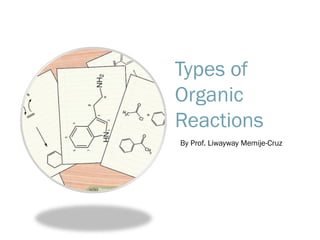
Types of Organic Reactions
- 1. Types of Organic Reactions By Prof. Liwayway Memije-Cruz
- 2. Organic reactions are chemical reactions involving organic compounds. organic reactions are used in the construction of new organic molecules. The production of many man-made chemicals such as drugs, plastics, food additives, fabrics depend on organic reactions.
- 4. What are the different types of organic reactions? 1. Substitution reactions 2. Elimination reactions 3. Addition reactions 4. Radical reactions 5. Oxidation-Reduction reactions
- 5. Types of Organic Reactions
- 7. Electrophiles molecule or ion that accepts a pair of electrons to make a new covalent bond (from the Greek for "electron loving"). same thing as a Lewis acid. molecule, ion or atom that is electron deficient in some way can behave as an electrophile. Electron deficiency would include a formal positive charge (methyl carbocation), a partial positive charge (d+), usually in conjunction with a polar bond (such as H-Cl) or an open octet (borane). "E" or "E+" are common abbreviations for generic electrophiles.
- 8. Nucleophiles molecule or ion that donates a pair of electrons to form a new covalent bond (from the Greek for "nucleus loving"). same thing as a Lewis base. Any molecule, ion or atom that has electrons that can be shared can be a nucleophile. The most common indications that electrons are available to be shared are formal negative charge (iodide ion), a partial negative charge (d-), usually in conjunction with a polar bond (methyl magnesium bromide), a p bond (isobutylene) or lone pairs (ammonia). "Nuc" or "Nu" are common abbreviations for generic nucleophiles.
- 10. Substitution Reaction reaction where one atom or a group of atoms is substituted by another atom or a group of atoms to form a new substance. example of C – Cl bond, in which the carbon atom usually has a partial positive charge due to the presence of highly electronegative chlorine atoms
- 14. Elimination Reactions involve the elimination and removal of the adjacent atoms. One of the examples of elimination reaction is the conversion of ethyl chloride to ethylene. CH3CH2Cl → CH2=CH2+ HCl In the above reaction the eliminated molecule is HCl, which is formed by the combination of H+ from the carbon atom which is on the left side and Cl– from the carbon atom which is on the right side.
- 16. Addition Reactions just the opposite of an elimination reaction. In an addition reaction, the components or molecules of A and B are added to the carbon-carbon multiple bonds and this is called an addition reaction. In the reaction given below when HCl is added to ethylene, it will give us ethylene chloride. HCl + CH2 = CH2 → CH3CH2Cl
- 18. Radical Reactions Most of the organic reactions involve radicals and their movement. Addition of a halogen to a typically saturated hydrocarbon involves free radical mechanism. There are usually three stages involved in a radical reaction which are, initiation, propagation, and termination. Initially when the weak bond is broken initiation of the reaction takes place with the formation of free radicals. After that when the halogen is added to the hydrocarbon a radical is produced and finally, it gives alkyl halide.
- 20. Oxidation–Reduction Reactions can often be identified by changes in the number of oxygen atoms at a particular position in the hydrocarbon skeleton or in the number of bonds between carbon and oxygen at that position increase in either corresponds to an oxidation, whereas a decrease corresponds to a reduction. increase in the number of hydrogen atoms in a hydrocarbon is often an indication of a reduction.
- 21. The Oxidation State of Carbon in Oxygen- and Nitrogen-Containing Functional Groups. (a) In a hydrocarbon, oxidation is indicated by an increase in the number of oxygen atoms or carbon–oxygen bonds or a decrease in the number of hydrogen atoms. (b) In nitrogen-containing compounds, the number of carbon–nitrogen bonds changes with the oxidation state of carbon.
- 22. The Oxidation State of Carbon in Oxygen- and Nitrogen- Containing Functional Groups. b) In compounds with a carbon–nitrogen bond, the number of bonds between the C and N atoms increases as the oxidation state of the carbon increases.
- 23. Summary The common classes of organic reactions—substitution, elimination, addition, oxidation-reduction, and radical—all involve reacting electrophiles with nucleophiles. There are common patterns to how organic reactions occur. In a substitution reaction, one atom or a group of atoms in a substance is replaced by another atom or a group of atoms from another substance. Bulky groups that prevent attack cause the reaction to be sterically hindered. In an elimination reaction, adjacent atoms are removed with subsequent formation of a multiple bond and a small molecule. An addition reaction is the reverse of an elimination reaction. Radical reactions are not very selective and occur in three stages: initiation, propagation, and termination. Oxidation–reduction reactions in organic chemistry are identified by the change in the number of oxygens in the hydrocarbon skeleton or the number of bonds between carbon and oxygen or carbon and nitrogen.
- 24. References: https://www.toppr.com/guides/chemistry/organic-c https://byjus.com/chemistry/types-of-organic-react https://www.wikihow.com/Learn-About-the-Types-o https://chem.libretexts.org/Textbook_Maps/ General_Chemistry/Map%3A_
